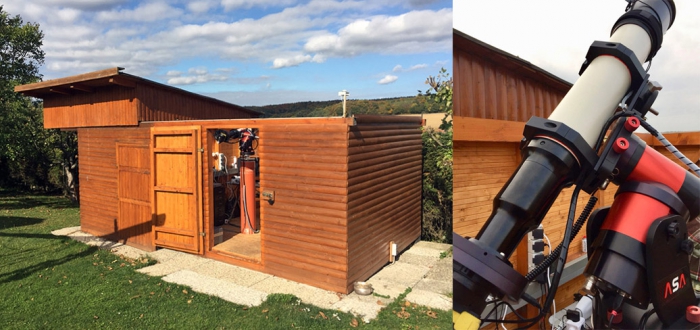Tele Vue-NP127fli Imaging the Skies Over Austria


The NP127fli is a 127mm / 5-inch, f/5.3, APO (Nagler-Petzval) astrograph with an optical arrangement of 5-elements in 3-groups. Its sole purpose is to create wide-field images — 4.3-degrees on the diagonal of the 52mm diameter image circle. From the image below you’ll note that this scope lacks a traditional focuser. This astrograph is designed to operate with the Finger Lakes Instrumentation (FLI) Atlas electronic focuser – hence the “fli” designation. The NP127fli is specifically designed so when the Atlas is at the center of its focus travel, the combined path-length of FLI focuser, filter-wheel and camera puts the CCD sensor at the focal plane of the telescope’s optics. In order to achieve this, the NP127fli’s “Large Field Corrector” lens (visible in the photo) physically sits inside the Atlas. The benefits of the Atlas over a typical manual rack & pinion focuser are: 85 nm/step size, ability to handle 25-lbs of equipment, and FLI’s Zero Tilt Adapter system.

I had my first contact with astronomy at the age of 14. At that time I visited the public observatory in Traiskirchen (25km south of Vienna) and was fascinated by the telescopes at first sight. My interest in astrophotography became apparent after a short time. At that time I made my first experiences with taking pictures of the night sky with a Super Polaris DX mount and telephoto lenses. A few years later the digital revolution “took place” and new and unimagined possibilities opened up in astrophotography. In 2005, a friend and I built our own observatory, which we equipped for remote imaging.

We asked him why he choose and uses the Tele Vue-NP127fli for astro-imaging.
I used an 8“ Newton for a few years. It was a very good telescope, but frequent collimating was annoying. So after a lot of research, my choice fell on the TeleVue-NP127fli. The telescope was usable out of the box. No collimation necessary and wonderfully corrected. Due to the compact design and the direct attachment of the image train, the telescope is very stiff. The short focal length is also ideal for my favorite objects – dark nebulae.

He also told us about his observatory.
My remote observatory is in a small village with about 400 inhabitants, so the light pollution is kept within limits (20.5 – 20.7 mag/arcsec2.). Nevertheless, Vienna and the surrounding cities are unfortunately brightening the sky more and more. Therefore, I also consider moving my entire equipment to a really dark place. Someday…

When not not exploring the night sky, Patrick works as an occupational psychologist at the Austrian workers compensation board. He also volunteers at the very same public observatory in Traiskirchen that inspired his love of the night sky.

- Patrick’s Instagram account
- Patrick’s website
- Tele Vue-NP127fli page (mobile site)
Did you observe, sketch, or image with Tele Vue gear? We’ll like your social media post on that if you tag it #televue and the gear used. Example:
#televue #tv85 #ethos #jupiter
Do you want your Tele Vue images re-posted on Tele Vue Optics’ Social Media accounts? Use this hashtag for consideration:
#RPTVO


